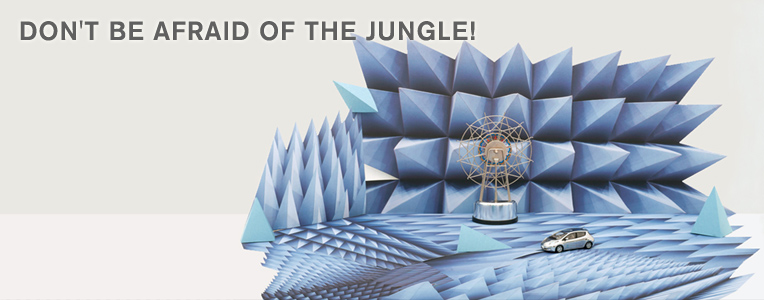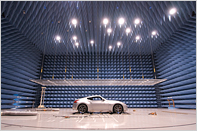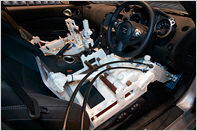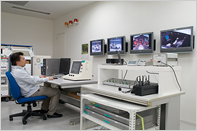Don't Be Afraid of the Jungle!

We live in a world of gadgets: Smartphones, laptops, tablets, Bluetooth earphones... Cars too are overflowing with electronic devices - and also radio waves.
Signals bounce between antennas and mobile phones. Laptops and tablets wirelessly stream content from the Web. Our voices and emails travel through the air. And this is all thanks to radio waves.
The electronic devices we see around us seem to increase every day - but so does what we cannot see. Radio waves will also keep on proliferating the more our lives get easier with Wi-Fi spots, e-money and mobile communication.

The wheels sit on a chassis dynamometer, a "rolling road" platform that can recreate driving conditions. Hanging antennae reflect radio waves off the car, checking for influence on the brakes, audio system, headlamps, windshield wipers and so on.
The same goes for driving. Radio waves are a car's best friend. Consider a car navigation system, which sends out electromagnetic signals to interact with a data center. It's because of this kind of electronic communication that Nissan could create the distance control assist system, where a car is aware of the distance between itself and the car in front.
But there is a dangerous side to these convenient radio waves. For example, if unchecked, the signals the car produces might cause interference with external things, such as TVs and radios. And, on the other hand, we need to also be sure the waves emitted from TV and radio antennas are not affecting the electrical parts inside a vehicle, such as in the engine, transmission, steering and brakes - and potentially putting the driver in danger. Developing a car that is immune to outside radio wave interference literally saves lives.
But this is easier said than done: We live in a "jungle" of radio waves. In order to be able to navigate this jungle safely, Nissan works to create cars that can figure out which waves are the necessary ones - and then only use them. For testing the influence of radio waves on cars Nissan has designed a massive 27 x 21 x 10 meter anechoic chamber, with walls covered in pointed and bumpy surfaces made from a special absorbent carbon foam. The radio waves radiating onto the vehicle are reflected off the walls, repeatedly bouncing back until absorbed into the absorbent material.

As strong radio waves are used, the test car is driverless and with the brakes and gearshift operated by a machine, made from plastic and wood since metal would be affected by the waves.
Every area's "jungle" also has its own regulations and frequencies. Nissan runs tests from 20MHz to 2GHz so that its cars can drive through any part of the world. Are the meters and gauges functioning correctly? Has the functionality of the car reduced? This all has to be checked for the radio wave standards in all countries, since any malfunction might interfere with some 40-50 important electrical components: Brakes, headlights, engine controls, autocruising, ABS, windshield wipers, and more.
During these tests the researchers are unleashing extremely powerful radio waves. Perhaps not surprisingly the anechoic chamber therefore uses a driverless vehicle, the controls handled by a robot. With so many different radio waves being zapped onto the hapless car, the room becomes a bit like a microwave. Inside the car there are cameras monitoring the test, as well as sensors recording data to check for malfunctions. The team in the control room then use these readings in conjunction with all the know-how they have accumulated over the years.
Ensuring a car can cope with all the various radio waves around the world is one thing but Nissan goes further into the jungle, using another smaller anechoic chamber to check for changes in the car navigation screen and improve quality. This time one of the testers, wearing a special protective suit, actually sits in the car.
Whereas the other tests are based on the differing standards around the world, this trial rather depends on the imagination of the engineers. "There may be customers who use their car navigation screen not in the default mode, but perhaps with the brightness setting at the highest," says the Electronics Engineering Development Division's Shin Saito. "We have to then test that there are no effects from radio waves if you do this." In this way the members of the team like Saito need rich imaginations to consider all the diverse scenarios that might arise, and run tests under even stricter conditions than for regular wireless devices.
We're used to that announcement about switching off mobile phones and other electronic devices on airplanes, right? But cars are an indispensable part of most people's daily lives and there is no way you could make such a demand. Take the Nissan LEAF, which can be charged up by household electricity. The team had to ensure that the car could do this without hindrance to itself - nor harm to others. They were rewarded with the first CE marking* for a car as a household appliance, fully approving the vehicle to be used in homes across the EU.
Nimble, tenacious and imaginative: Navigating through this dense tangle of radio waves, Nissan's dedicated teams pursue their constant tests in the very deepest reaches of the jungle, maintaining the total safety and performance of our cars.
* A CE marking is given to products that meet the standards of all member states of the EU and is a sign of its reliability.

Due to the effects of the radio waves it is hard to read data from measuring devices during the test. Cameras photograph the test and then engineers check with the human eye if the blinkers and wipers and so on are functioning correctly

